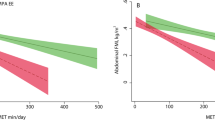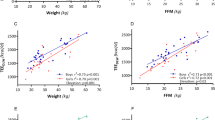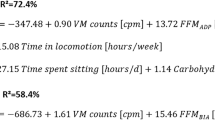Abstract
BACKGROUND: Few data exist on the energy cost of specific activities in children. The influence of body weight on the energy cost of activity when expressed as metabolic equivalents (METs) has not been vigorously explored.
OBJECTIVE: To provide MET data on five specific activities in 12-y-old girls and to test the hypothesis that measured MET values are independent of body weight.
SUBJECTS AND METHODS: In 17 12-y-old girls, resting metabolic rate (RMR) and the energy expended while sitting, standing, walking on a flat treadmill at 3.2 and at 4.8 km/h, and walking on a treadmill at a 10% incline at 4.8 km/h were measured using indirect calorimetry. MET values were calculated by dividing the energy expenditure of an activity by the subject's RMR. The influence of body weight was assessed using simple linear regression.
Results: The observed METs were more consistent with published values for similar activities in adults than those offered for children. Body weight was a statistically significant predictor of the MET of all three walking activities, but not the MET of sitting or standing. Body weight explained 25% of the variance in the MET value for walking at 3.2 km/h, 39% for walking at 4.8 km/h, and 63% for walking at a 10% incline at 4.8 km/h.
CONCLUSION: METs for the three walking activities were not independent of body weight. The use of average MET values to estimate the energy cost of these three activities would result in an underestimation of their energy cost in heavier girls and an overestimation in lighter girls. These results suggest that the estimation of total energy expenditure from activity diary, recall, and direct observation data using average MET values may be biased by body weight.
This is a preview of subscription content, access via your institution
Access options
Subscribe to this journal
Receive 12 print issues and online access
$259.00 per year
only $21.58 per issue
Buy this article
- Purchase on Springer Link
- Instant access to full article PDF
Prices may be subject to local taxes which are calculated during checkout

Similar content being viewed by others
References
Ainsworth BE, Haskell WL, Leon AS, Jacobs DR, Montoye HJ, Sallis JF, Paffenbarger RS . Compendium of physical activities: classification of energy costs of human physical activities. Med Sci Sports Exerc 1993; 25: 71–80.
Godin G, Shephard RJ . Body weight and the energy cost of activity. Arch Environ Health 1973; 27: 289–293.
Institute of Medicine. Dietary reference intakes for energy, carbohydrates, fiber, fat, protein and amino acids. The National Academies Press: Washington, DC; 2002. pp 697–735.
Ainsworth BE, Haskell WL, Whitt MC, Irwin ML, Swartz AM, Strath SJ, O'Brien WL, Bassett Jr DR, Schmitz KH, Emplaincourt PO, Jacobs Jr DR, Leon AS . Compendium of physical activities: an update of activity codes and MET intensities. Med Sci Sports Exerc 2000; 32: S498–S504.
Torun B . Energy cost of various physical activities in healthy children. In: Schürch B, Scrimshaw NS (eds). Activity, energy expenditure and energy requirements of infants and children. International Dietary Energy Consultancy Group: Switzerland; 1989. pp 139–183.
Bouchard C, Tremblay A, Leblanc C, Lortie G, Savard R, Theriault G . A method to assess energy expenditure in children and adults. Am J Clin Nutr 1983; 37: 461–467.
Torun B . Inaccuracy of applying energy expenditure rates of adults to children (letter). Am J Clin Nutr 1983; 38: 813–814.
FAO/WHO/UNU. Energy and protein requirements. Report of a joint FAO/WHU/UNU Expert Consultation, World Health Organization, Geneva 1985.
Must A, Dallal GE, Dietz WH . Reference data for obesity: 85th and 95th percentiles of body mass index (wt/ht2) and triceps skinfold thickness. Am J Clin Nutr 1991; 53: 839–846.
Bandini LG, Schoeller DA, Edwards J, Young VR, Oh SH, Dietz WH . Energy expenditure during carbohydrate overfeeding in obese and nonobese adolescents. Am J Physiol 1989; 256: E357–E367.
Bandini LG, Morelli JA, Must A, Dietz WH . Accuracy of standardized equations for predicting metabolic rate in premenarcheal girls. Am J Clin Nutr 1995; 62: 711–714.
Weir JBdV . New methods for calculating metabolic rate with special reference to protein metabolism. J Physiol 1949; 109: 1–9.
Centers for Disease Control and Prevention, National Center for Health Statistics. 2000. CDC Growth Charts: United States, May 2002 Internet: http://www.cdc.gov/growthcharts (accessed 21 May 2002).
Tanner JM . Growth and endocrinology of the adolescent. In: Gardner LI (ed). Endocrine and genetic diseases of childhood and adolescence. W.B. Sanders: Philadelphia, PA; 1975. pp 14–54.
Torun B, Davies P, Livingstone M, Paolisso M, Sackett R, Spurr G . Energy requirements and dietary energy recommendations for children and adolescents 1 to 18 years old. Eur J Clin Nutr 1996; 50: S37–S81.
Schoeller DA, Jefford G . Determinants of the energy costs of light activities: inferences for interpreting doubly labeled water data. Int J Obes Relat Metab Disord 2002; 26: 97–101.
Maffeis C, Schutz Y, Schena F, Zaffanello M, Pinelli L . Energy expenditure during walking and running in obese and nonobese prepubertal children. J Pediatr 1993; 123: 193–199.
Levine JA, Schleusner SJ, Jensen MD . Energy expenditure of nonexercise activity. Am J Clin Nutr 2000; 72: 1451–1454.
Bandini LG, Schoeller DA, Dietz WH . Energy expenditure in obese and nonobese adolescents. Pediatr Res 1990; 27: 198–203.
Maffeis C, Zaffanello M, Pinelli L, Schutz Y . Total energy expenditure and patterns of activity in 8–10-year-old obese and non-obese children. J Pediatr Gastroenterol Nutr 1996; 23: 256–261.
Treuth M, Figueroa-Colon R, Hunter G, Weinsier R, Butte N, Goran M . Energy expenditure and physical fitness in overweight vs. non-overweight prepubertal girls. Int J Obes Relat Metab Disord 1998; 22: 440–447.
Farrell SW, Braun L, Barlow CE, Cheng YJ, Blair SN . The relation of body mass index, cardiorespiratory fitness, and all-cause mortality in women. Obes Res 2002; 10: 417–423.
Wei M, Kampert JB, Barlow CE, Nichaman MZ, Gibbons LW, Paffenbarger Jr RS, Blair SN . Relationship between low cardiorespiratory fitness and mortality in normal-weight, overweight, and obese men. JAMA 1999; 282: 1547–1553.
Acknowledgements
We gratefully acknowledge the girls who participated in this study as well as the staff at the General Clinical Research Center at MIT for their assistance. This study was supported by NIH Grants MO1-RR00088, DK-50537, 5P30, and DK46200.
Author information
Authors and Affiliations
Corresponding author
Additional information
Presented in part at the North American Association for the Study of Obesity annual meeting in Long Beach, CA (October 2000).
Rights and permissions
About this article
Cite this article
Spadano, J., Must, A., Bandini, L. et al. Energy cost of physical activities in 12-y-old girls: MET values and the influence of body weight. Int J Obes 27, 1528–1533 (2003). https://doi.org/10.1038/sj.ijo.0802440
Received:
Revised:
Accepted:
Published:
Issue Date:
DOI: https://doi.org/10.1038/sj.ijo.0802440
Keywords
This article is cited by
-
Time with friends and physical activity as mechanisms linking obesity and television viewing among youth
International Journal of Behavioral Nutrition and Physical Activity (2015)
-
Relation between body mass index and depression: a structural equation modeling approach
BMC Medical Research Methodology (2007)



